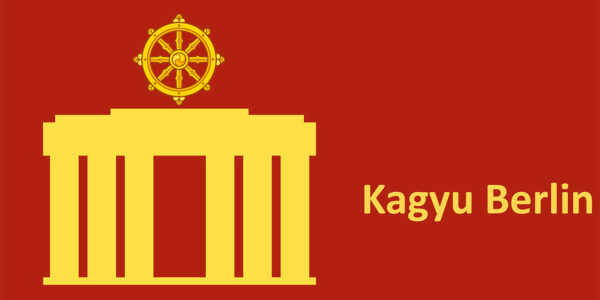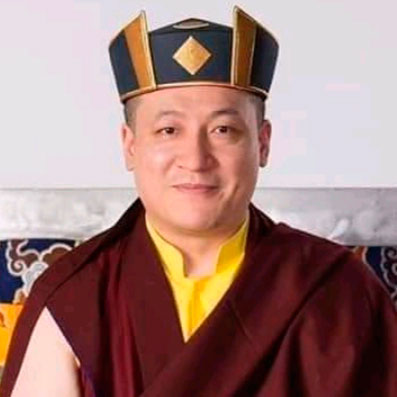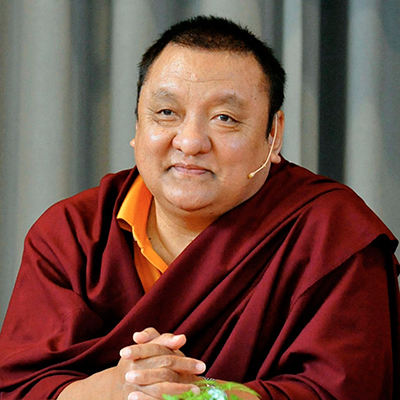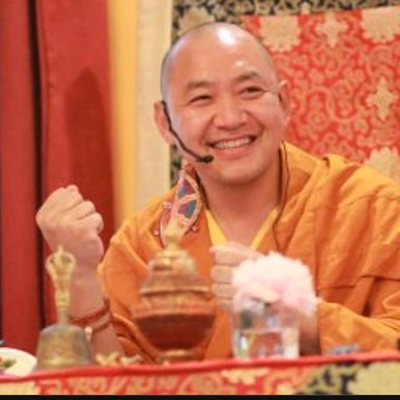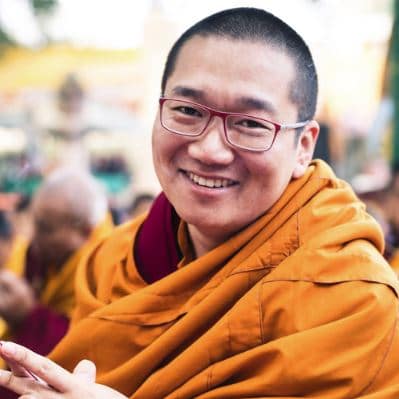Our Teachers
The Teachers Significance in Tibetan Buddhism
The teachers’ role has a special significance in the Karma Kagyu lineage of Tibetan Buddhism:
there is an unbroken lineage of transmission into our present day going back directly to the historical Buddha Shakyamuni
as a matter of principle the teachers pass on the Dharma teachings, meditations and initiations directly to the students in person
the teachers serve as living examples that realization and enlightenment are also possible for us
The following teachers of the Karma Kagyu lineage are fundamental companions and supporters since many years for us at Kagyu Berlin.
17. Gyalwa Karmapa Trinley Thaye Dorje
The 17th Gyalwa Karmapa Trinley Thaye Dorje is the spiritual head of the Karma Kagyu lineage, one of the four main branches of Tibetan Buddhism. Karmapa was born in Tibet in 1983. As soon as he could speak, he told his parents he was the Karmapa. In 1994, the family managed to escape to India. In accordance with the 900-year-old tradition of the Karma Kagyu lineage, he was enthroned in March 1994 by the 14th Kunzig Shamarpa Mipham Chökyi Lodrö, the second highest lineage holder of the Karma Kagyu lineage. From Shamar Rinpoche he also received the name Thaye Dorje, which means “Boundless, Unchanging Buddha Activity”. Gyalwa Karmapa received his formal education with teachers from all four major Tibetan schools and graduated in 2003 with the title of “Vidyadhara”, knowledge holder of the sutras and tantras.
The 17th Gyalwa Karmapa continues the activity of his predecessors worldwide, both in the traditional form of oral teachings and in keeping with our times through his social media channels. H.H. the 17th Karmapa has the spiritual responsibility for over 900 monasteries and meditation centers worldwide. In 2017, Karmapa married Sangyumla Rinchen Yangzom, and in 2018 their son Thugsey was born.
The Karmapas are among the most important holders of the teachings of Tibetan Buddhism. The first Karmapa, Düsum Khyenpa (1110-1193), one of the most important lamas of his time, indicated to his disciples before his death that he would take rebirth in Tibet. The second Karmapa, Karma Pakshi (1204-1283), is thus considered the first consciously reborn lama (Tulku) of Tibet and is therefore the founder of the Tulku system, which is still part of Tibetan Buddhist culture today. Since then, each Karmapa incarnation has clearly identified himself as the Karmapa through his own statements and conduct, and has been confirmed as the incarnation of the previous Karmapa by one of his realized disciples.
The Karmapas are considered great Bodhisattvas, i.e. beings who repeatedly take rebirth and teach the Dharma for the benefit of others. In their incarnations the Karmapas have always made an important contribution to the authentic preservation of Buddhism. The 16th Karmapa, Rangdjung Rigpe Dorje (1924-1981), also made a very significant contribution to making the teachings of Tibetan Buddhism accessible in the West, establishing both the monastic tradition and the lay Buddhism of the Karma Kagyu lineage in Western countries. The 17th Gyalwa Karmapa Trinley Thaye Dorje is now continuing this legacy with a focus on education, young people and developing inner wealth to achieve personal and global peace.
14. Sharmapa Mipham Chökyi Lodrö
The 14th Shamarpa Mipham Chökyi Lodrö is the second highest teacher and lineage holder of the Karma Kagyu lineage. He was born in 1952 in Eastern Tibet and was recognized by the 16th Karmapa Rangdjung Rigpe Dordje as the 14th rebirth of the Shamarpa The eincarnation lineage of the Shamarpas goes back to the 13th century.
The first Shamar Rinpoche, Khedrub Tragpe Senge (1283 – 1349) was the main disciple of the third Karmapa, Rangdjung Dordje. His second incarnation, Katschö Wangpo, received the Red Crown from the fourth Karmapa Rölpe Dorje, an exact replica of the latter’s own Black Crown, as a symbol of their inseparability. With the Red Crown, the 4th Karmapa gave him the name Shamarpa – the one with the Red Crown. The Shamarpas have incarnated as disciples or teachers of the Karmapas since the 14th century
In accordance with the tradition of the Karma Kagyu school, the 14th Shamarpa Mipham Chökyi Lodrö received full transmission of the Karma Kagyu teachings from the 16th Karmapa. At the request of the 16th Gyalwa Karmapa Rangdjung Rigpe Dorje, Shamar Rinpoche completed Karmapas main seat and the Institute for Buddhist Studies in India, New Delhi , the “Karmapa International Buddhist Institute – KIBI”. Here, universal wisdom and compassion are promoted through the study of Buddhist teachings. In 1996, Shamar Rinpoche initiated the network of Bodhi Path Centres worldwide.
On the morning of 11 June 2014, Shamar Rinpoche passed away at the Bodhi Path Centre Renchen Ulm at the age of 61.
Dupseng Rinpoche
The current, third Dupseng Rinpoche is a vajra master who guides his students, both ordained and lay people, in their practice of the Buddhadharma on all levels. He is the retreat master responsible for the traditional Karma Kagyu three-year, three-month retreat at Karma Ngedon Palbar Ling Retreat Centre, Sarangkot, Nepal. For his lay students, Rinpoche has been travelling and teaching for years, holding group retreats and leading smaller and larger groups on shorter and longer retreats. In 2018, a long-held desire finally bore fruit, and a retreat programme for lay yogis based on the curriculum of the traditional three-year, three-month retreat was launched. It is Rinpoche’s endeavour to lead his lay disciples to the same attainments as the traditional practitioners in a programme tailored to the conditions of modern life. The programme is offered through regular events Rinpoche holds in Thailand, Nepal, Denmark and possibly in Germany in the future.
During his last two lives Rinpoche has devoted his activities to deep retreat practice, and in this life he continues this great work. After his recognition, Rinpoche received teachings, oral transmissions and empowerments from various teachers and lineage holders and completed several retreats, for example at Le Bost in France.
In 2003, Rinpoche went to Cambridge University, UK, to study English literature and theology. Rinpoche completed his degree in English language and literature and obtained a Master’s degree in theology in 2007.
In addition to his work as a retreat master, Rinpoche also looks after Jangchub Choling Monastery, Vikramashila Buddhist Institute, Dupgyud Choling Monastery with a total of 160 monks, as well as the Kagyu Institute for Buddhist Studies in Kirtipur / Kathmandu and Tharpa Choling Nunnery in Muktinath with 48 nuns. In addition, Rinpoche is frequently invited by his disciples to Australia, Eastern and Western Europe, the USA, South America and Canada to teach all levels of the Buddha Dharma, which is the source of momentary and ultimate happiness.
.
(From www.dupseng.de)
Sabchu Rinpoché
Sabchu Rinpoché was born in Nepal. The late 14th Shamar Rinpoche formally recognized him as the 5th incarnation of Sabchu Rinpoché during the transmission of the Tersar empowerments at Nagi Gompa by the late Tulku Urgyen Rinpoche. The formal ceremony took place twice, first at Rumtek Dharma Chakra Centre and then at Swayambhu Monastery.
Rinpoché moved to Swayambhu Monastery at a young age and began to study the Tibetan language and the basic practices of the Karma Kamtsang lineage. He received many empowerments, reading transmissions and teachings from great masters.
Sabchu Rinpoché received many practice instructions from various qualified meditation masters. He studied the scriptures and philosophical treatises under Khenpo Shenpen and later under Khenpo Chödrak Rinpoche at the Karmapa International Buddhist Institute.
He spent a year practicing Chöd in Pharping. At the age of eighteen he began a three-year retreat under the guidance of Maniwa Sherab Gyaltsen Rinpoche. At this occasion Sabchu Rinpoché received the Karma Kamtsang transmissions that are traditionally practised in retreat. He then began to travel and teach in Europe and North America. After several years of travelling and teaching, Rinpoché completed a bachelor’s degree in film and media production in Canada. Rinpoché divides his time between personal retreat and teaching in Asia and Europe. Sabchu Rinpoché is the abbot of Karma Raja Mahavihara Monastery on Swayambhu, Kathmandu and regularly guides many students in the West in retreats and on- and offline Dharma events.
(From www.sabchu.org)
Tulku Tseyang Rinpoche
Tulku Tseyang Rinpoche is the 4th reincarnation of a great Mahasiddha whose fame spread beyond the borders of Western Tibet. He was formally recognised by H.H. Shamar Rinpoche and given the name Karma Lungthok Tenpai Nyima. The formal enthronement ceremony and hair cutting of Tulku Tseyang Rinpoche took place during the Kagyu Monlam Festival in Bodh Gaya on 25. December 1996 in the presence of His Holiness the 17th Karmapa Trinley Thaye Dorje and His Holiness Shamar Rinpoche.
He completed all his Buddhist studies and received his certification from the Vikramashila Buddhist Institute. After completing the traditional three-year retreat in Pharping, Nepal, he was appointed Vajra Master of Jangchub Choeling Monastery in Pokhara, Nepal, where he teaches the monks. In addition, Rinpoche mentors Western students for example in Nyung-Nay retreats and Dharma events.
